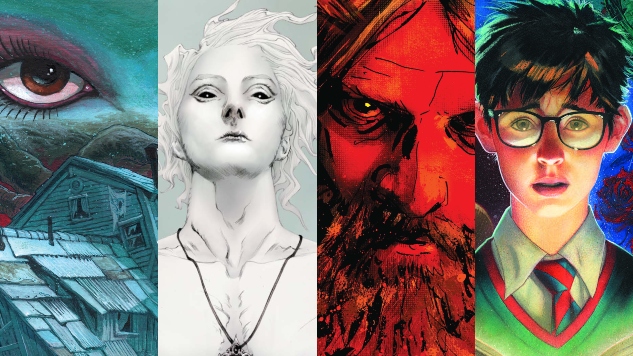
While there’s always been a standard for literary cleverness in The Sandman and its various
spinoffs, few would call Neil Gaiman and co.’s Vertigo magnum opus “funny.” The writers behind its current revival, on the other hand, are an absolute riot, especially when you gather them all on a Slack channel for an hour-long chat about the state of The Sandman Universe, DC’s banner for Sandman tales. While finding a time slot that worked for participants stretching from California to New York to the U.K. was a struggle, it was worth it to witness Lucifer writer Dan Watters continuously trot out his Mazikeen voice, or learn from House of Whispers co-creator Nalo Hopkinson and Books of Magic scribe Kat Howard about adapting to comics from the prose world. And, of course, The Dreamingmastermind Simon Spurrier provided his trademark witticisms throughout, both keeping the chat on track and sending it careening off into drinking-game territory.
With a year two for The Sandman Universe officially confirmed, and initial trade collections for The Dreaming and Lucifer on shelves and House of Whispers and Books of Magic not far behind, Paste picked the minds of these four writers to learn more about feeling ownership of these titles, collaborating with top-tier artistic partners, how fandom has changed over the decades and what’s next for The Sandman Universe. Check out a (lightly edited) transcript of the conversation below, and be sure to pick up each of the four Sandman Universe titles at your local comic shop or preferred digital retailer.

Paste: I’d love to start with just a state of the union. Each of you has at least eight issues of your respective series on shelves, which I’m guessing means you’ve all written through almost two full arcs. In brief, elevator-pitch form, where does each of your titles stand right now? What’s next up on your Sandman to-write list? Where are you all in your Sandman journeys?
Kat Howard: I’m in revisions on #12 for Books of Magic, in which magic happens, secrets are revealed and someone meets a very bad end.
Nalo Hopkinson: Learning how to write comics by starting with one of the best-loved properties out there. Daunting much? Grateful for the chance to work with Dan Watters, from whom I’m learning a lot. As to House of Whispers, shit is going wolf-howlingly wild, the deathless are dying and borders between worlds are being breached. And Black Girl Magic is in full effect.
Howard: Hahaha, right Nalo? I try not to think about that when I’m writing, or my scripts would be 22 pages of “aaaahhh this is the coolest and most intimidating job ever!”
Hopkinson: Next up is the beginning of year two—not sure it’s public yet that we’ll be having a year two? [editor’s note: it is now!]
Dan Watters: Thank you Nalo! And likewise, I’m learning loads from you on the book. It’s going to really wild places. It’s really interesting to see where strategies and styles meet up and diverge across mediums.
Simon Spurrier: I think we’re up to issue #10 with The Dreaming. In the first arc we saw what happens to the Dreaming (which is basically the realm of the shared human unconscious masquerading as an insane fantastic frontier town) when its Lord and Master disappears. Short answer: sinister forces try to take over.
In the second arc, we’ve ended-up with a new (and very reluctant) master on the throne. His first port of call has been to try and find Dream, the missing King, in an attempt to try and set everything back to normal. So the past few issues have been these lovely little done-in-one stories, featuring members of our extended cast tracking the movements of the absent King before he disappeared.
Watters: I’m currently two volumes down script-wise with Lucifer, which has actually taken us up to issue #13, as we’ve had an extra issue drawn by Kelley Jones, which was a total dream come true—that one [is] out this month. Our second arc centers around Lucifer deciding to restore his reputation, and I don’t think it’s a spoiler to say that’s probably going to end poorly or bloodily or both for everyone in his vicinity.
Paste: A few of you spoke with Paste when The Sandman Universe launched, and we of course talked about the expectations of taking on such a storied comics legacy. Has the pressure of following in Neil Gaiman’s footsteps lightened at all in the last year? Do you find yourselves feeling more ownership over the books as time goes on? Is Neil still a regular guiding presence or are the issues we’re seeing still spinning out of initial brainstorming talks?
Hopkinson: Dunno ‘bout everyone else, but my experience with HoW is that Neil’s hand has been very light. From the beginning, he wanted us to write our own stories. He gave us a quick-’n-dirty backgrounder and effectively said, “Now, go play.” So I’ve been pretty free, Neil-wise, to figure out what I’m playing at.
Spurrier: I think I speak for us all when I say you just can’t do this sort of book without some sense of ownership. Not legally, perhaps, but definitely in an authorial sense. As well as offering oversight (and some annoyingly well-crafted idea-nuggets just when you need ‘em), I think his biggest gift has been the permission to not only borrow his toys, but to treat them as if they’re ours.
Hopkinson: A couple times he made a helpful suggestion, and that’s been mostly it.
Watters: Yeah, definitely. I think that was the tactic I needed to take in the first place with Lucifer—there are so many iterations of this character, trying to replicate Neil’s or Mike Carey’s or Holly Black’s would have been too petrifying. So I pushed it very much into the negative space of what I thought hadn’t been done with him yet.
Howard: I definitely feel more comfortable inhabiting the characters now than I did at the beginning, and for me, a lot of that is the art team I’m working with. I know that Tom Fowler can draw pretty much anything. Brian Churilla has joined the team and is doing gorgeous work, and Jordan Boyd’s colors are stunning. So I feel like I’m working with a net.
Hopkinson: And I’ve had fun importing a couple of relatively minor characters from the Dreaming (minor with one or two exceptions) and folding them into the goings-on in the House of Whispers.
Howard: I didn’t really feel intimidated by writing characters that Neil had written so much as working in the world, initially—I wanted to be certain that I would do justice to the story. At this point, I feel like I am.
Spurrier: I mostly worry I’m going to kill Bilquis [Evely, artist on The Dreaming]. Page 1, panel 1: small panel, maybe 1/30th of the page, as eight-million demons—all of them unique and highly detailed—rush towards us. Please leave room for dialogue, etc., etc.
Watters: I wrote a scene for arc two which began with an army of angels appearing over Milan Cathedral, and the Fiumara brothers [Max and Sebastián, artists on Lucifer] didn’t even blink…
Paste: Ha! That’s a great segue because I’d feel guilty if we didn’t talk about the art. I was going to pose the question as: how have your artistic collaborators challenged you and your approach? But it sounds like you’re mostly torturing them to the best of your abilities.
Spurrier: Eh. Artists. They deserve it.
Watters: Yup.
Spurrier: Otherwise they’ll start getting ideas above their station. “I can write too, you know.”
Hopkinson: And I’ve had extraordinary fun working with Domo [Stanton, artist on HoW] in creating a story centered largely around Black and brown people’s experiences, histories and stories, and also making it QAF [queer as fuck].
Howard: Tom did a character design for issue #9 that literally gave me nightmares, so I feel a little less bad about what I’ve asked him to draw now.
Watters: The one note that the Fiumaras gave me near the beginning of the book—right after we did the Sandman Universe one-shot—is that they were excited to play with panel shapes and sizes and do the unexpected, as that was one of their takeaways from Sandman. So I’ve been able to let them absolutely loose on the pages and they’ve delivered every time.
Spurrier: (I jest, obviously.) Bilquis is frighteningly good. Like, top-10-in-the-world-level good. I confess to being more than a little annoyed that she didn’t get an Eisner nod. She handles whatever I throw at her with humor and grace, and hasn’t ONCE failed to improve on the image in my head. It’s got so I can write “another one of our trademark DPS Drew Struzan-style montages” and almost feel her grinning halfway across the world. Comics. Fucking amazing when the collaboration really clicks.
Hopkinson: When I first met Domo in person, a few months into our working together, we were on a panel at San Diego Comi-Con, and he told the audience that he liked creating unexpected frames, and drawing stuff getting smashed. So now I look out for opportunities for him to do both. And I send him a lot of footnotes with reference images, cultural information, etc. He’s been a beast about absorbing it all and generating amazing pages.
Watters: These have to be some of the hardest books to draw, right? The limits of their locals are “the human imagination.”
Spurrier: Yeah, ‘xactly.
Watters: *locales. First typo goes to Dan!
Spurrier: Not like you can just google image references for Ideaspace, or The Realm Between Realms, or whatever.
Hopkinson: And not just Domo; so many wonderful artists associated with this story. Sean [Andrew Murray]’s covers have made me squeal with glee from the very beginning. John [Rauch] and Deron [Bennett] are doing stuff with colors and lettering that add extra layers of vividness and legibility to the pages.
Howard: (I was a little (a lot) grumpy that none of the artists on these books got Eisner nods. These books are gorgeous!)
Spurrier: Dan: DRINK
Howard: No, if Dan drinks there will be more typos.
Watters: wha yer on abouh I type behhah wen I’ve ad a few.
Paste: I can edit out typos. Please, everyone who wants to drink, drink.
Spurrier: Kat: absolutely, re: the artists. It’s a helluva crew.
Paste: I think Dan just slipped into Mazikeen voice.
Hopkinson: Nine in the morning here. I’m so bleary-eyed—this is the final week of classes—I couldn’t find a bottle to drink from. Not actually sure what I’m typing, either.
Howard: And 20 minutes in is the moment when the interview went completely off the rails.
Watters: I’ve written [Mazikeen] in cafes a couple of times, and had to try and hide that I was mouthing dialogue phonetically out of half of my mouth.
Hopkinson: There were rails?! No one told me there were rails!
Spurrier: Nobody mentioned Trump or Brexit yet. We’re doing great. DRINK.
Howard: Dan: That is amazing. I love it.
(chuckle) picturing Dan miming Mazikeen.
Paste: Speaking of Mazikeen, and hopscotching back to Kat talking about being a steward of this world (and to desperately avoid Trump or Brexit), I wanted to throw this one out there too—one thing that struck me as I caught up on the last few issues of each series is that we’re seeing more familiar faces fold into the stories: The Corinthian, the Egyptian pantheon, Nuala, Titania. What sort of thinking goes into balancing character callbacks with introducing new faces to the lore?
Spurrier: Urgh. Picturing Mazikeen doing a drinking game. Also Dan pretending to be Mazikeen doing a drinking game.
Hopkinson: Now I’m picturing Dan wearing Mazikeen’s outfits, and everything’s just gotten that much more inappropriate. Cute, though.
Watters: Haha!
Howard: Thinking makes it sound like I have a plan (I have a plan!?). For me, it’s mostly been, here’s this character that I love and wow, how can I work them into the story so I can write them.
And I just looked up and caught Nalo’s comment and now I’m dead.
Hopkinson: Balancing character callbacks; for me, I just think of characters I’d like to get my hands on, then I figure out with Dan how we might do that while we ask the editors, Neil and the others if we can use them. Don’t want to step on storylines.
Watters: On the characters: it was something I really wanted to avoid at first, which was a lot easier for me than some of the others—Lucifer is very much an island. I wanted to establish this book with its own tone and two-legs before I started worrying about callbacks. Now we’re on firmer ground, more pre-existing characters are definitely going to crop up.
Spurrier: Yeah, what Kat said, basically. There’s a lot of deep roots in all these book, I think—certainly true of TD—that speak to our inner fans as well as our inner creators. The trick is to install value and progression in revisiting the source material, as well as love.
Hopkinson: The old guy with the one swan wing -I think we’ve named him Prince Theodore—caught my eye when I first noticed him working in Dream’s palace, because I figured I knew who he was. So I’ve been finding ways to sneak him in from the very beginning.
Watters: “The trick is to install value and progression in revisiting the source material, as well as love.”—Very, very much this! And a character like the Swan Prince is great fun, as he has something like three panels of page-time in Sandman? So fleshing him out and working out who he is was really interesting.
Hopkinson: I pretty much had to bring in Cain and Abel, since they were in Neil’s initial note. I have a love/hate relationship with those two, but I quite adore their pet gargoyles, especially Goldie. So Goldie’s around a lot in the earlier issues. And Gregory has a crush on my man-gator character, Uncle Monday.
Paste: I think that progression comment is pretty brilliant. As a longtime franchise fan, I’ve been impressed that all of the “cameos,” for lack of a more graceful word, have come with actual growth or recontextualization, not just, “Oh, here’s that character you recognize.”
Howard: Yeah, the “deep roots of love” that Si mentioned—that’s been a foundation of this project from the beginning for me. Part of the joy of writing it is working in a universe I love, with characters I love, and finding a way to bring what I can to their stories.
Spurrier: Dirty confession: I just killed a bit-part character from the Sandman books. It felt goodbad.
Howard: Filthy murderer.
Hopkinson: killkillkill
Spurrier: Murder is a form of progression, right?
Howard: (I say, having once apologized to my grandmother for the amount of entrails on the page.)
Spurrier: Hahah. Mmm. Entrails.
Hopkinson: Part of the challenge for me is bringing those characters into a story based in a very real, current and much misrepresented religion that is of West African origin. I could write a whole essay on that, but I’ll leave that to the essay-writing folks.
Watters: If I had to apologize for the amount of entrails in Lucifer, I’d probably not get anything else done.
Paste: Changing gears a little bit: what has surprised you the most in your time with The Sandman Universe? This can be a non-comics inspiration that found its way into your work, an unexpected fan response, a character you didn’t think you’d connect with so strongly, whatever comes to mind when you read “surprised.”
Spurrier: Does “it’s hard” count? It’s hard.
Hopkinson: For me, it was hearing from readers who are familiar with my work who couldn’t figure out how to get the comic. There are people out there for whom comics shops are just not on their radar, and who would probably be uncomfortable going into one.
Watters: Aha! It’s very hard. The stakes are intrinsically malleable—because that’s how dreams work—so you have to really make them count and be felt. I’ve realized what a feat it is that Neil made that look so effortless the first time round.
Howard: I didn’t really come in with expectations, more like this constant, running prayer of, Dear God, don’t let me eff this up. So I’m not sure that I have a thing that has surprised me as such, as I don’t know what to be surprised by.
Hopkinson: A delightful surprise was reading Deron talking about his approach to lettering. I think it gets overlooked as an art form, but you can’t ignore that when Deron speaks.
Spurrier: Like… literally any other IP, one can abstractly achieve levels of really high quality comickery without necessarily having to sweat blood over every detail. But The Dreaming... it’s a perfect storm of my own affection for Neil’s work, the need for emotional honesty from characters who are about as far removed from myself as it’s possible to get; the need for verisimilitude in unreal situations; the need for veracity of detail with folklore, magic, mystery; and the tonal expectation—because of the Sandman books—for a particular standard of cleverness, story-symmetry and closure. Short version: the bar is high. It’s all entirely self-inflicted pressure, but my god. Never before have I been so paranoid about letting a clunker of an issue out the door. I don’t think it’s happened yet. Jesus, I can’t spell either. DRINK.
Paste: Not to split you all off, but since the conversation kind of naturally steered here: Kat and Nalo, Books of Magic and House of Whispers are, respectively, your first comic outings. Now that you’ve banked more issues, how has it felt to adapt to the medium on such a major stage? Has your approach changed over time in any conscious way?
Hopkinson: A more disconcerting surprise has been having readers complain that they’re struggling to figure out what’s going on. I reread the original Sandman stories and remember having to make peace with my own confusion. So I think, “You’re a Sandmanfan, but you expected the new stories to be immediately transparent? Did you read the same Sandman I did?”
Howard: I feel like I’m running across a highwire telling myself not to look down.
Paste: Not to insert myself too much, but I do think attention spans have changed a lot in terms of sequential media in the last few decades. And with the Vertigo classics specifically, SO many readers came to them once they were over and binge-able. For a lot of readers, myself included, this is our first time reading The Sandman monthly.
Hopkinson: I am, kicking and screaming, getting more plot-driven. From my years of writing fantasy and science fiction, I know that shit has to happen. But in this type of comic, it has to happen in every panel, because it’s immediately obvious if things are dragging. And it has to happen BIG.
Howard: I’m not sure I can point to specifics yet, in terms of how my process has changed, because I am very consciously trying to up my game with each issue.
Hopkinson: I’m in awe of and doing my best to emulate Dan’s skills at taking an element that barely showed up in a previous issue and bringing it back onstage to contribute in a huge way. So much fun, doing that!
Watters: Ha, thanks Nalo. I’ve also been learning a lot in that respect—I’ve not written anything this dense or longform before, so plotting way out ahead rather than feeling my way has been something I’ve enjoyed more than I thought I ever would in all honesty.
Spurrier: (Nalo: re Reader cognisance, I feel your pain. One of the comicsphere’s dirty tendencies, I’m afraid. It’s something I’d counsel you gently to ignore, and it comes almost entirely from misguided expectations. People build up an understanding of the internal logic stories much more easily over the course of a whole series than they do a few issues. Nostalgia for something they’ve already digested makes people unfairly harsh about things they haven’t yet eaten.)
Howard: But also, yes, I agree with Nalo—I’m focusing much more on plot here than I would in my prose. Partially because when I write a novel, I have the whole thing in front of me, and I can go back and change things if I need to. Whereas in writing comics, it’s more like needing to leave my presents out for my future self and future stories because I can’t go back and fix things!
Hopkinson: Si: yeah, you right. Can we strike that comment of mine, please?
Howard: (argh, why is there a my in front of presents in that sentence. DRINK)
Paste: “A Boozy Conversation With the Creators of The Sandman Universe”
Hopkinson: What Kat said! I remember how horrified I was when I realized that writing a monthly serial means that if I go down a road that’s going to lead me into difficulty, I can’t go back and fix it, because the issue where I put it into motion will have been released already. Yikes, yikes, yikes.
Howard: Right? Whose idea was that, anyway, set pieces of story just out in print where anyone can read them!
Watters: I kind of love that jazz element of comics. It can lead you into beautiful knots.
Spurrier: (Strike it if you wish! But FWIW I think it’s a really worthy thing to note. Coming from outside of comics, I bet you and Kat are exposed to all sorts of unexpected idiosyncrasies, good and bad, of the comment-sphere.)
Hopkinson: There’ve been great idiosyncrasies from fans, too. Like the person who figured out Domo had had to change some of the visible elements of a sex scene. He did it purely by observation of what was in the panel, and he impressed me all to hell.
Spurrier: I had to do a pretty major plot-adjustment somewhere around issue #5. Luckily had time and space to fiddle before and after the break. I think it ended up better than I’d planned it. Editors are the bestworst.
Paste: Right along those lines: Dan, you’re working with Nalo on House of Whispers, and Kat and Si, both of your titles have recently brushed against the Faerie. The world of The Sandman Universe is, by nature, as infinite as imagination, but should we expect to see the books begin to play with each other in any larger ways? Or are they set to remain four autonomous storytelling vessels?
Howard: Spoilers, sweetie
Paste: Ha!
Watters: Haha! We have had Mazikeen show up recently in House of Whispers for one. By the time these books are done, everything’s going to be Mazikeen. All the time.
Howard: Oh, now I extremely want her and Mad Hettie to hang out.
Hopkinson: Plus, we’re all off working furiously on our own stories with their own trajectories. Difficult to interrupt that train if someone wants to borrow one of our characters. They may be busy doing other things. It’s possible, but has to be handled carefully.
Watters: Ish guhra ghe hrilliant.
Hopkinson: Mazikeen and Mad Hettie needs to happen. I had fun having Mazikeen and Erzulie the love deity hang out for a bit. I just knew they would like each other. (Giggling at Danikeen).
Spurrier: I think… and all-a-y’all should correct me if I’m speaking out of turn… and DC should activate the NDA human/computer interface virus we’ve all been contractually obligated to download if I’m out of order here… but I think the interconnectedness of these books is something we’re treating quite tenderly. There are tendrils, there are abstract plans, there are shadows moving on the cave wall. When our various characters look up, they’re all looking at the same moon (well, actually, they’re not, but fuck off, I’m being poetic). The one thing we’re NOT doing right away—and this is perhaps Neil’s biggest and only dictat—is a Big-Two-style crossover WITH THE FATE OF MULTIVERSES AT STAKE. That’s not what The Sandman Universe is all about.
Not saying it won’t happen, not saying we don’t have ideas, but if it ever did it would be a) clever, b) subtle and c) beautiful.
Not saying it won’t happen, not saying we don’t have ideas, but if it ever did it would be a) clever, b) subtle and c) beautiful.
Paste: I’m grateful for the a, b and c of that. We’re somehow bumping up against our allotted time already, so please consider this the open season portion for anything else you want to say about your books, or ask your peers about their books, or type out in a Mazikeen voice just for the heck of it.
Watters: (Lucifer can burn down his own multiverses, thank you very much.)
[DC Representative]: I appreciate that poetic response so no NDA.
Spurrier: Relief. DRINK
Watters: DRINK
Howard: (I mean, there is this prophecy of Tim destroying all the Universes. Nothing says he needs help.)
Hopkinson: Hell, handcarts, and productive confusion. DRINK
Howard: HRINK.
[DC Representative]: Well I think that’s the time to cut you ALL OFF.
Hopkinson: Aw…
Spurrier: Wait, nobody barfed yet. We can’t stop now.
Watters: You don’t have to go home, but you can’t stay here.
Howard: I love everybody in this bar
Hopkinson: Cue Cheers theme song, and now we’re all barfing.
Spurrier: We have beautiful poetic whimsical mature-content barfing to do.





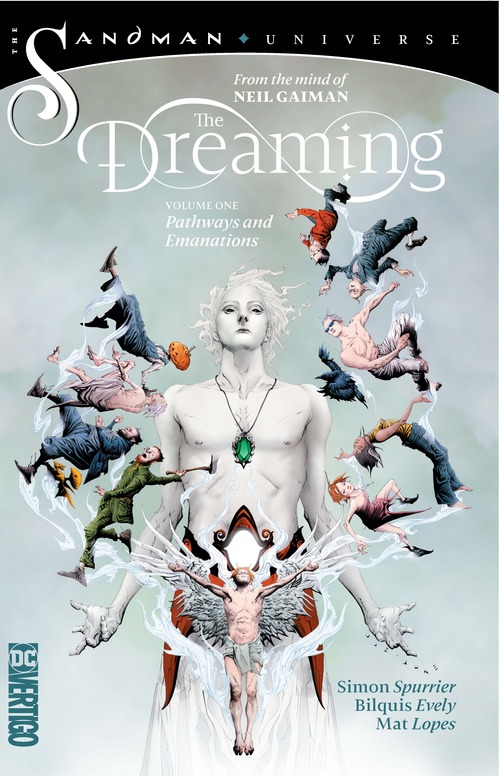
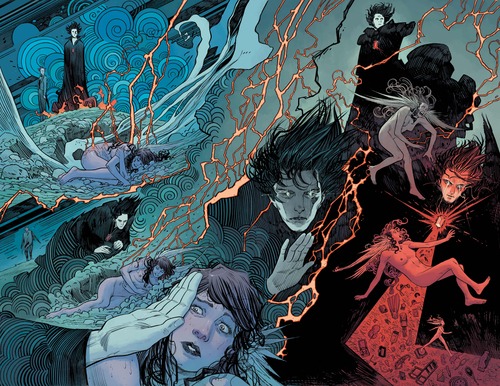
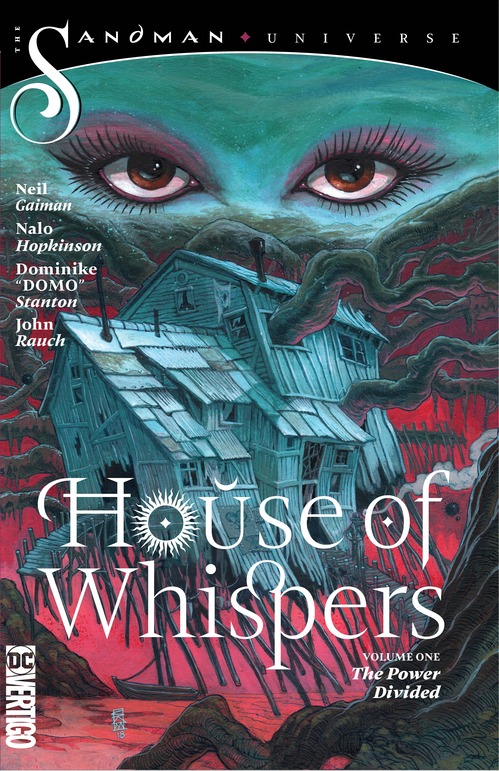


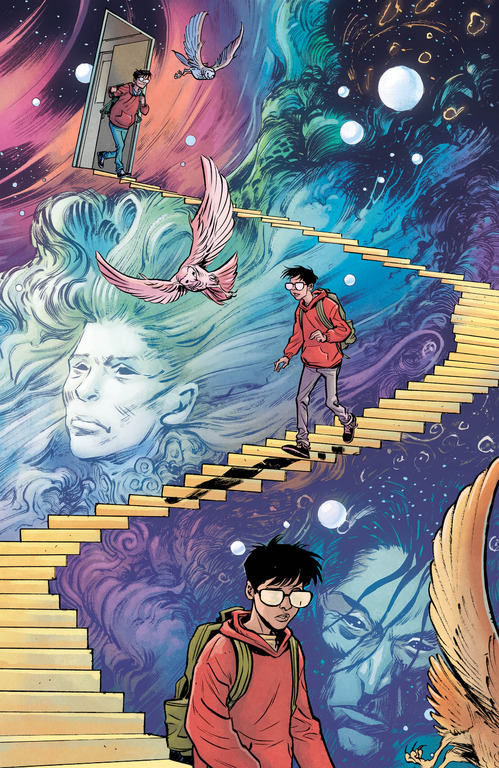
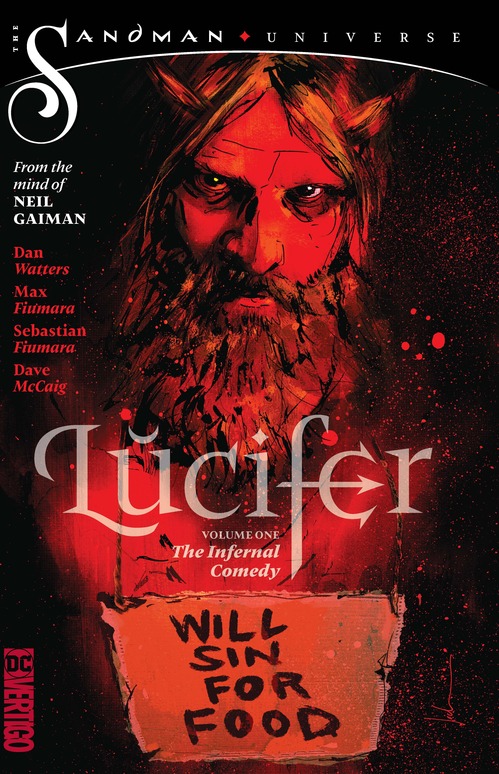
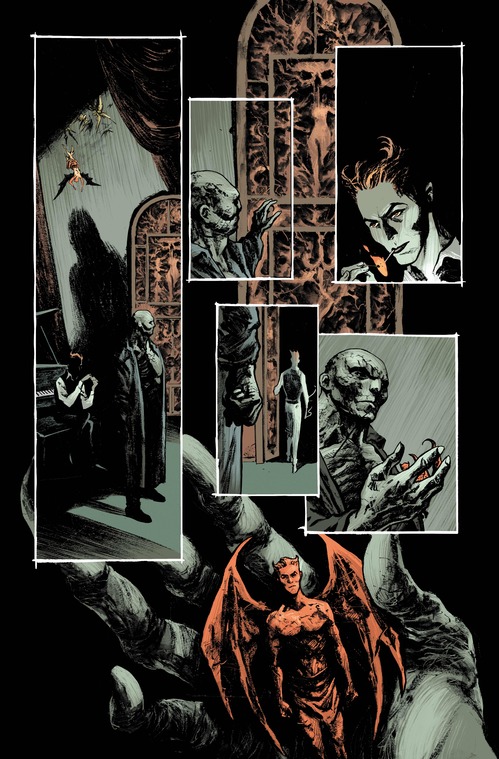
Комментариев нет:
Отправить комментарий